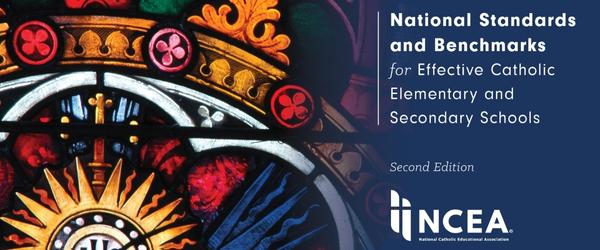The NCEA NSBECS Advisory Council (NNAC) is proud to present the NSBECS, Second Edition! The NNAC worked for over three years to complete this document. Thanks to the NNAC members, former and current, as well as the many people in dioceses across the U.S. who have provided feedback on these standards.
What has not changed about these standards?
The standards that were written in 2012 led by Dr. Lorraine Ozar and Dr. Patricia Weitzel-O’Neill included nine Defining Characteristics of Catholic Schools which were derived directly from the Holy See’s teaching on Catholic schools that were then compiled by Archbishop J. Michael Miller, CSB. These defining characteristics were strengthened with citations from Pope Benedict XVI and Pope Francis.
Also not changed from the first edition are the four domains of the standards: Mission and Catholic Identity, Governance and Leadership, Academic Excellence and Operational Vitality. The first edition had 13 standards, and the second edition also has 13 standards.
What has changed in the second edition?
First, like the defining characteristics, there are more recent Church document citations added throughout the document. The second edition has 76 benchmarks as compared to 69 benchmarks in the first edition. The reason for this change was twofold: first, some users of the NSBECS reported that some of the benchmarks were too dense, making it challenging to measure everything the benchmark required. Second, there were things missing in the first edition; for example, the first edition did not include anything about charism in Domain One.
Another change in the second edition is the strengthening and clarity of verbiage. The word “Christ” appears four more times in the second edition, and the word “Catholic” appears seven more times. Catholic social teaching and service learning are directly addressed.
An example of strengthening verbiage occurs in Standard 4 now states, “An excellent Catholic school adhering to mission provides opportunities for Christ-centered adult faith formation and action in service of missionary discipleship and social justice,” adding the phrase “Christ-centered.” Benchmark 12.1 calls for “measurable objectives” instead of “objectives” from the first edition. More specificity was added, including benchmark 1.6: “Supplemental statements such as the school’s motto, beliefs, philosophy, core values, charism, and/or graduate profile are aligned with the school’s mission statement and are inspired by the school’s Catholic identity.” (Previously 1.4 “The mission statement is visible in public places and contained in official documents.” 1.5 “All constituents know and understand the mission.”).
In the Academic Excellence domain, two changes made include the explicit language around the inclusion and addressing of the academic needs of diverse learners. Also, the terms “21st century learners” and “habits of mind” were removed and replaced with executive function and specific, more modern descriptions of technology use.
The goal of the NSBECS continues to be excellence in each Catholic school in every one of the four domains: Mission and Catholic Identity, Governance and Leadership, Academic Excellence, and Operational Vitality. Schools are using the NSBECS for accreditation and self-study for progress and continued excellence. The NNAC is hopeful that the second edition can sustain and possibly improve these processes.
The tools of the standards—the guidelines, surveys, rubrics and worksheets—are being revised and should be completed by December 2023. The revisions will be housed on the NCEA website. In the meantime, we encourage you to visit the NCEA Store for your free download of the standards for members. Hard copies are also available for purchase.
This blog was written by Michelle P. Lia, Ed.D., Co-Director, Andrew M. Greeley Center for Catholic Education, Clinical Associate Professor, School of Education, Loyola University Chicago
